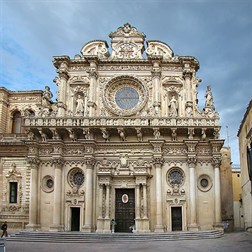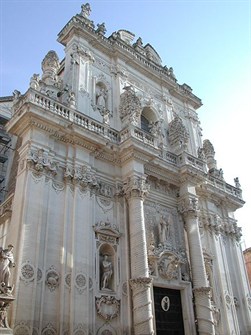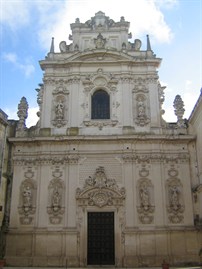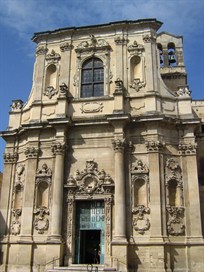Churches of Lecce
The architect and sculptor Giuseppe Zimbalo (1620-1710) is widely considered the greatest exponent of the Baroque in Lecce. The grandson of Francesco Antonio Zimbalo, another famous architect in the history of Lecce, Giuseppe Zimbalo is also known as the Zingarello, an Italian translation of the word in dialect Zimbarieddu or, literally, “little Zimbalo”, to distinguish him from his father and grandfather, both dedicated to the same art.
 The third and most famous member of the Zimbalo family produced some of the most important buildings of Lecce. In addition to the reconstruction of the Cathedral, the design of the bell tower and the raising of the Column of Sant’Oronzo, Zimbalo also contributed to the building, which was conducted over many centuries, of the Basilica of Santa Croce, which, along with the former Celestine convent, now seat of the Province of Lecce, constitutes one of the major architectural complexes in the city. The project was started in 1549 on land obtained from the confiscations from the Jewish community expelled from the city in 1510. The first phase of work, which lasted until 1582, led to the construction of the lower area of the façade, up to the balcony, and was directed by the architect Gabriele Riccardi. The second phase, in 1606, met with the contribution of Zimbalo’s grandfather, Francesco Anthonio, who added the three decorated portals. The third and last phase of the work were undertaken by Zingarello with Cesare Penna, another illustrious exponent of the Baroque in Lecce: their mastery provided the upper part of the façade, the rose window and the gable on the top of the structure. The date 1646 is carved near the rose window.
The third and most famous member of the Zimbalo family produced some of the most important buildings of Lecce. In addition to the reconstruction of the Cathedral, the design of the bell tower and the raising of the Column of Sant’Oronzo, Zimbalo also contributed to the building, which was conducted over many centuries, of the Basilica of Santa Croce, which, along with the former Celestine convent, now seat of the Province of Lecce, constitutes one of the major architectural complexes in the city. The project was started in 1549 on land obtained from the confiscations from the Jewish community expelled from the city in 1510. The first phase of work, which lasted until 1582, led to the construction of the lower area of the façade, up to the balcony, and was directed by the architect Gabriele Riccardi. The second phase, in 1606, met with the contribution of Zimbalo’s grandfather, Francesco Anthonio, who added the three decorated portals. The third and last phase of the work were undertaken by Zingarello with Cesare Penna, another illustrious exponent of the Baroque in Lecce: their mastery provided the upper part of the façade, the rose window and the gable on the top of the structure. The date 1646 is carved near the rose window.
 The construction of the Church of San Giovanni Battista (Saint John the Baptist), or del Rosario, was instead entrusted by the Dominicans to Zimbalo when he was already over seventy years old. The aged architect, who devoted himself to the work from 1691 until his death in 1710, contributed personally to the financing of the work. Still incomplete at the death of its creator, the structure was completed in 1728 by some local artists, and Zimbalo had asked to be buried in it.
The construction of the Church of San Giovanni Battista (Saint John the Baptist), or del Rosario, was instead entrusted by the Dominicans to Zimbalo when he was already over seventy years old. The aged architect, who devoted himself to the work from 1691 until his death in 1710, contributed personally to the financing of the work. Still incomplete at the death of its creator, the structure was completed in 1728 by some local artists, and Zimbalo had asked to be buried in it.
In addition to being the author of the Memorie, a chronicle of events that took place in Lecce between 1656 and 1719, Giuseppe Cino (1645-1722) was one of the greatest exponents of the Baroque in Lecce. An architect and sculptor, his training took place under the guidance and influence of the great masters who worked in those years in the town of Salento, above all Giuseppe Zimbalo.
Many of the most representative monuments of Baroque in Lecce were attributed to Cino.
 The Church of the Carmine, adjacent to the Carmelite convent, was instead built according to a design by Cino, who worked there from 1711 until his death in 1722. The work, which in this case, was accomplished by Mauro Manieri, or according to other sources, by Cino’s brother, Donato, has a façade which is divided into three orders. In the first order, four niches which are placed symmetrically on either side of the portal retain the great statues of the prophets Elijah and Elisha and the Carmelite Saint Angelus of Jerusalem and Saint Albert of Trapani. The figure of the Madonna del Carmine (Our Lady of Mount Carmel), to whom the church is dedicated, appears on the curvilinear tympanum of the portal. In the second order, a central window divides the two niches occupied by statues of Saints Theresa of Avila and Mary Magdalene of Pazzi. The third order visually unifies the entire structure of the composition of the façade and gable ends with a classically inspired pediment. The interior of the church instead reproduces the shape of the human foot, with six chapels, three on each side, enriched by splendid Baroque altars.
The Church of the Carmine, adjacent to the Carmelite convent, was instead built according to a design by Cino, who worked there from 1711 until his death in 1722. The work, which in this case, was accomplished by Mauro Manieri, or according to other sources, by Cino’s brother, Donato, has a façade which is divided into three orders. In the first order, four niches which are placed symmetrically on either side of the portal retain the great statues of the prophets Elijah and Elisha and the Carmelite Saint Angelus of Jerusalem and Saint Albert of Trapani. The figure of the Madonna del Carmine (Our Lady of Mount Carmel), to whom the church is dedicated, appears on the curvilinear tympanum of the portal. In the second order, a central window divides the two niches occupied by statues of Saints Theresa of Avila and Mary Magdalene of Pazzi. The third order visually unifies the entire structure of the composition of the façade and gable ends with a classically inspired pediment. The interior of the church instead reproduces the shape of the human foot, with six chapels, three on each side, enriched by splendid Baroque altars.
 The reconstruction of the Church of Santa Chiara (Saint Clare), between 1687 and 1691, must be included among Cino’s works. The façade, divided into two orders, also presents various niches which are symmetrically arranged on either side of the portal, in the lower order and the central window in the upper order. The church has an octagonal elongated plan, with a deep chancel covered with vaulted ceilings.
The reconstruction of the Church of Santa Chiara (Saint Clare), between 1687 and 1691, must be included among Cino’s works. The façade, divided into two orders, also presents various niches which are symmetrically arranged on either side of the portal, in the lower order and the central window in the upper order. The church has an octagonal elongated plan, with a deep chancel covered with vaulted ceilings.
Aside from as an architect, Giuseppe Cino represented Baroque art with some fine sculptures, especially altars. The altars of Saints Charles Borromeo and Andrew the apostle, for example, in the Cathedral of Lecce, are attributed to him.
